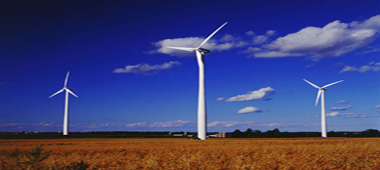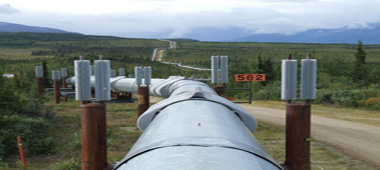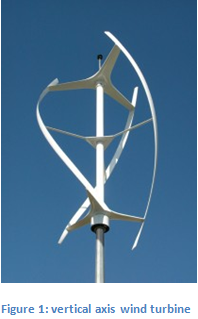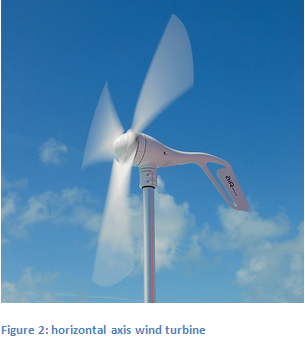Wind energy
During the last decade, wind energy has grown significantly. The energy produced by this source emerged from a concept that is of a negligible proportion compared to the important key players in energy markets. In some countries, the proportion of wind energy reaches just 10%; in Denmark particularly, it accounts for more than 20%. Wind power is often considered as the most important renewable resource; however, this is a very debatable point.
The idea of getting energy from wind is very simple. A wind drives a rotor which is connected to a power generator, which then supplies the grid with electricity. However, nothing in energy is as straight forward as it may appear to be. Wind mills have many weaknesses and many technological challenges, which need to be addressed by researchers and engineers.
To begin with, let’s start with the various types of wind turbines. At the first level, we could divide them into two big groups. There are turbines with vertical and horizontal axes. Both of them are shown in figures 1 and 2 respectively. The first group is vertical axis wind turbines, which are far less popular than the horizontal axis turbines. There are several good reasons for this difference. They are bigger; heavier and even so, have lower performance. The deficit of performance is the main reason why the main developers have chosen the other – horizontal axis architecture. Although vertical axis wind turbines have several advantages. The most important one is probably independence on wind direction. Therefore, these turbines are suitable for places with varying and unstable wind directions. The most powerful wind turbine with vertical axis is 110 m high and its performance is 3.8 MW [1]. However, most of these kinds of turbines are very small and they are usually used as additional power sources on bigger buildings.
The turbines with horizontal axis are for the wind power industry and have much more important architecture. Problems caused by variable wind directions are partially solved by rotor pitch control and turbine yaw control. Power generated by these turbines is often up to 5 MW. The recent projects of offshore wind farms are designed for turbines with power up to 10 MW. Those powerful turbines can be built offshore due to stronger and more regular wind. The other important reason is the social aspect as big wind mills might disturb people by changing the landscape and producing noise. The wind turbines are usually concentrated in wind farms, which often have common control units. These units contain, apart other instrumentation, one or several transformers and they are responsible for farm connection to the grid. It is rather easy to connect wind farms to the grid, however, they pose a principal problem given today’s system balancing practices, because they cannot contribute to maintaining the system balance.
As everyone knows, there is no place where wind speed and wind direction can be guaranteed. There are places with more regular winds, however, wind turbines need 100% back-up all the same. The latter point is by far the biggest problem of this particular energy source. From the technical point of view, variable wind speed is a serious engineering issue and it makes wind turbines much more complicated. Wind variations cause the generator to require special binding with the rotor, or with the grid, or with both. Here, the wind turbines with horizontal axis are divided again into 3 groups. The first one is a constant speed wind turbine. The generator is connected directly to the grid and is equipped with relatively simple feedback electronics. Power from the rotor, is transformed through a gear box into the generator. As the rotation of the rotor and the generator is constant, the generator output power is adaptable. This is not really a complicated issue by standard types of generators (variable magnetic field of the rotor). The real problem is that constant wind turbines are more than 10 – 15 % less effective than they would be with variable speed. In addition, they have gearboxes with massive torque load and failures are very common. These kinds of turbines are also quite noisy compared to the other types.
The other kinds of the wind turbines are both variable speed. They are doubly fed induction generator and direct drive generator. The doubly fed induction generator type requires a gearbox. As the mechanical speed of the generator varies it must be decoupled from the electrical frequency of the grid and it requires a special converter for grid connection. This architecture is rather more effective than the previous one, though employment of the electrical converter introduces some losses. Again, the problematic part - the gearbox is present due to this architecture.
The gearbox failures are the main motivation for employment direct drive wind turbines. In this case, the usage of the gearbox is avoided; however, the generator is much bigger, more complicated and more expensive. The generator must also be decoupled from the grid and the converter is essential. Recent research and development focuses primarily on wind turbines with direct drive generators, as many challenges remain in the design these kinds of generators with maximal efficiency and lowest price. Nowadays, a high ratio of existing wind turbines is direct driven and also new forthcoming projects are almost exclusively based on this type of architecture.
To sum up, it is important to note that wind energy is an efficient and carbon free energy source. Recent technologies allow us to produce a significant proportion of electricity by this source.
The other important issue which must be mentioned is the fact that wind turbines do not have zero impact on the environment. Apart of noise and potential danger for birds, massive employment of wind power could change the power of the wind which would consequently affect local weather. The land might get warmer and dryer which would change local ecosystem.
Michal Chudy
References
[1] "Wind Energy Power Plants in Canada - other provinces". 2010-06-05. Retrieved 2010-08-24





